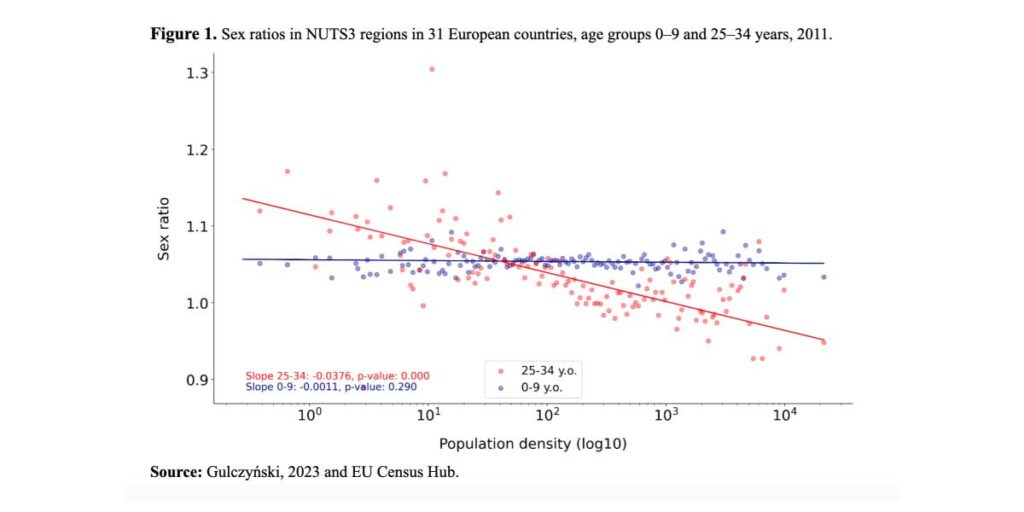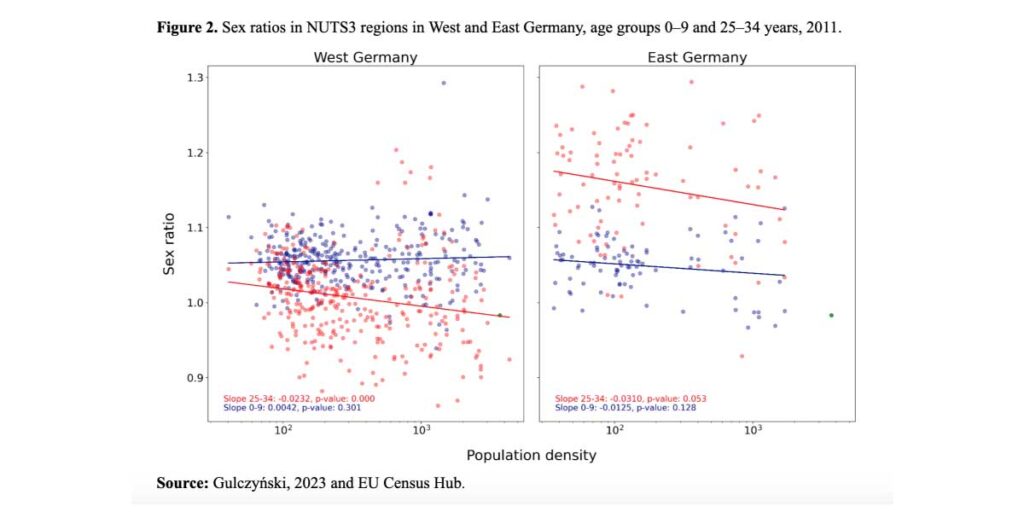Sex-selective migration leads to imbalances in local proportions of young women and men. In almost all European and American countries, substantially more women than men migrate from rural to urban areas, while in Africa, the opposite is true. Overall, observes Michał Gulczyński, this implies that many women and men may never find a suitable partner.
Declining marriage rates, and unpartnered living more generally, have been a growing concern in recent years. Causes are varied. Education, for instance, may have played a role, because there do not seem to be enough well-educated men for the increasing number of women with college degrees (Lichter et al. 2020). However, there may be an even more basic obstacle in the search for an opposite-sex partner: young women and men live in different places.
Obviously, this does not mean that they do not cross paths, but in local areas, sex ratios (young women divided by young men, where young means between 25 and 34 years of age) are unbalanced, which implies that there are not enough potential partners around. In a recent article (Gulczyński 2023), I show that the problem is more pervasive than commonly believed: in most countries of the world, both rural and urban sex ratios are frequently skewed.
Sex-selective migration leads to skewed subnational sex ratios all over the world
Figure 1 shows the strong correlation between (log) population density and sex ratios among young adults in subnational (NUTS 3) regions of the European Union. The higher the population density, i.e., the more urban a region, the higher the proportion of young women who live there. For instance, in the Polish capital city, Warsaw, there are around 10% more young women than men. In contrast, there are five young men for every four young women in rural Greece.

The problem also affects Germany, for instance, where, after re-unification, many women migrated from East to West, distorting the sex ratio (Figure 2): in some East German regions there are almost 13 young men per 10 young women. Some observers believe this to be one of the reasons behind the support for the right-wing party Alternative für Deutschland among the men left behind (Bennhold 2018).

So far, the phenomenon of skewed sex ratios has been observed mainly in extreme contexts, for instance, when a war eliminates a large share of young men or when many more boys than girls are born (Chao et al. 2019) due to sex-selective abortion. The most striking example of prenatal sex selection on a massive scale is China, where it developed in response to the one-child policy combined with strong son-preference and access to ultrasound scans to learn a child’s sex before birth. In normal circumstances, only up to around 5–7% more boys than girls are born.
Since both differential male and female mortality and abnormal sex ratios at birth are rather rare, the only other possible explanation of skewed sex ratios among young adults is sex-selective migration. In developed countries, women migrate to cities to study, work in services and take advantage of public services. Men are more likely to stay in rural areas. They are not necessarily farmers, but they commute more often and over longer distances. They also drop out of education earlier than women. However, there are also exceptions: in Africa, for instance, it is generally men who have a stronger tendency to migrate to urban areas.
Rural urban migration is gender selective
The phenomenon of skewed sex ratios is not new. It was noticed in the 19th century by Ernst Ravenstein (1885) who formulated one of his laws of migration as “woman is a greater migrant than man”. This was also recognized by the famous sociologist Pierre Bourdieu (1962) in his “Célibat et condition paysanne”. Already back then, both prominent scholars noticed that men were more likely to stay in rural areas.
Even if the phenomenon is not new, it may lead to more serious consequences nowadays. Political competition is shaped, among other things, by the rural-urban divide. The topic of gender and gender identities has become much more salient with the increasing representation of women in politics, expanding gender equality policies, and new social movements, such as #MeToo. Also, women’s migration to cities is now linked to the increasing gender gap (in favour of women) in education, which is still a source of prestige.
Recent migration flows may have a different gender balance than in the recent past. While migrants coming to Europe in the last decade were mostly male, most current Ukrainian refugees are women and children. And recent research shows that people react negatively to migration if their sex is over-represented, both in their home region and among migrants (Dancygier et al. 2021, Krakowski and Sambanis 2023).
It is reasonable to argue that gender equality should include living in the same places, having access to similar public services, and getting similar education. Otherwise, the gender gaps in values, lifestyles and political preferences are likely to continue, and possibly even increase, potentially posing serious policy issues in the near future.
References
- Bennhold, Kathrin. 2018. “One Legacy of Merkel? Angry East German Men Fueling the Far Right.” New York Times. www.nytimes.com/2018/11/05/world/europe/merkel-east-germany-nationalists-populism.
- Bourdieu, Pierre. 1962. “Célibat et condition paysanne.” Études rurales 5, no. 1: 32–135. https://doi.org/10.3406/rural.1962.1011.
- Chao, Fengqing, Patrick Gerland, Alex R. Cook, and Leontine Alkema. 2019. “Systematic Assessment of the Sex Ratio at Birth for All Countries and Estimation of National Imbalances and Regional Reference Levels.” Proceedings of the National Academy of Sciences 116, no. 19: 9303–11. https://doi.org/10.1073/pnas.1812593116.
- Dancygier, Rafaela, Naoki Egami, Amaney Jamal, and Ramona Rischke. 2021. ‘Hate Crimes and Gender Imbalances: Fears over Mate Competition and Violence against Refugees’. American Journal of Political Science n/a (n/a). https://doi.org/10.1111/ajps.12595.
- Gulczyński, Michał. 2023. Migration and Skewed Subnational Sex Ratios among Young Adults. Population and Development Review, onlie first. https://doi.org/10.1111/padr.12577.
- Krakowski, Krzysztof, and Nicholas Sambanis. 2023. ‘Mating Market Competition Reduces Support for Ukrainian Refugees Among Polish Women’. https://doi.org/10.2139/ssrn.4404955.
- Lichter, Daniel T., Joseph P. Price, and Jeffrey M. Swigert. 2020. ‘Mismatches in the Marriage Market’. Journal of Marriage and Family 82 (2): 796–809. https://doi.org/10.1111/jomf.12603.
- Ravenstein, Ernst. 1885. “The Laws of Migration.” Journal of the Statistical Society of London 48, no. 2: 167–235. https://doi.org/10.2307/2979181.

No comments:
Post a Comment